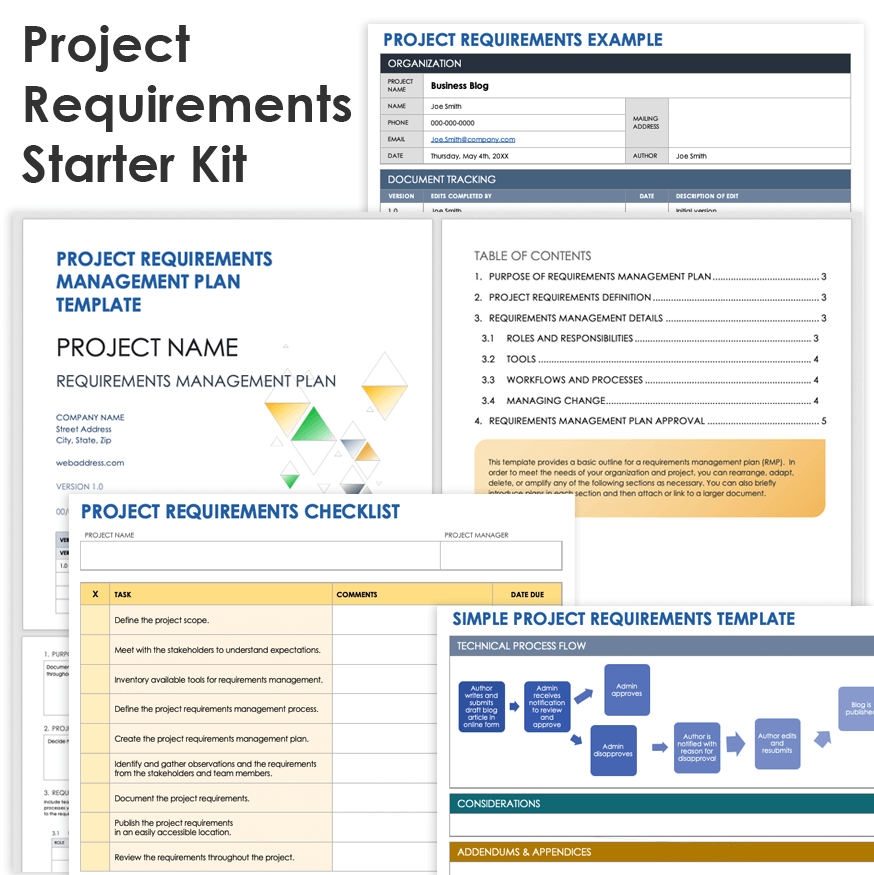What Are Project Requirements?
Project requirements are the necessary conditions and functions that you must include for a project to be considered complete. Project closure can only happen when you meet customer and stakeholder needs.
Project requirements may be business or technical requirements. Business requirements include the high-level business needs the project must achieve, while technical requirements define how the project will fulfill the business needs.
Alan Zucker, the Founding Principal of Project Management Essentials, shares how project requirements fit into the project management plan: “The project management plan is a comprehensive document that guides the planning and execution of the project. One of the sections in the project management plan is the project requirements management plan, which explicitly describes how requirements will be analyzed, documented, and managed. Components of the plan include how requirements will be collected and prioritized; how changes to requirements will be analyzed, reviewed, and approved; and the process and tools for tracing requirements through the design, development, and quality assurance processes.”
Project Requirements vs. Objectives
Project objectives are high-level business goals that contribute to an organization’s vision, while project requirements are specific actions necessary to complete a project.
For example, a project objective may be to build a roadway that reduces commute time into the city, while a project requirement is that the roadway must have three lanes in each direction.
How to Develop a Project Requirements Management Plan
To create a project requirements management plan, you’ll need to define three key elements: the project scope, the methodology or process, and the execution plan.
According to A Guide to the Project Management Book of Knowledge (PMBOK® Guide), the project requirements management plan is “a central document that defines the basis of all project work. The project management plan defines how the project is executed, monitored, controlled, and closed. The project management plan’s content varies depending upon the application area and complexity of the project. It is developed through a series of integrated processes extending through project closure.”
Requirements management is essential to project success. First, you define the project scope, which drives the rest of the requirements management plan. The scope provides critical information that informs all requirements necessary to complete the project and helps avoid scope creep.
“You must make certain expectations are outlined,” says Ben Timmerman, Vice President of Software Engineering at The Brookfield Group. “We prefer to template our requirements and set standards around what is expected to be included in every task. Then we break down our requirements into both functional and technical requirements. Functional requirements define the functions and purposes behind the components of the work being completed. The technical requirements outline the specific data requests and calls needed via an API.”
The project requirements management plan will note stakeholders, a definition of the requirements, who will manage the requirements, how you will track each requirement, and what you will do to manage change.
“We want to use processes and practices aligned to the type of project and organization,” says Zucker. “Managing requirements for constructing an office building, road, or sewage treatment plant will differ from a software project. And for software projects, life-critical applications will have different needs than a tool used by a few dozen people.”
Project Requirements Analysis Process
Teams perform project requirement analysis to ensure project clarity, completeness, and relevance. The purpose is to design a product to meet stakeholder needs.
The project requirements analysis process is as follows:
- Identify Stakeholder Requirements: You can use several methods for identifying requirements, including reviewing previous project materials and brainstorming sessions.
- Document Requirements: Create an official record of all requirements, and store it in an easily accessible location to keep everyone on the same page.
- Manage Progress: The project requirements document is one piece of the larger project management puzzle. Managing progress throughout the project will ensure all deliverables meet the stakeholder's expectations.
How Do You Identify and Gather Project Requirements?
Gathering project requirements is one step in the requirements management process and typically takes place at project onset. To gather requirements, talk with stakeholders, document all observations, and review the project as a team.
These seven research techniques will help you identify and gather project requirements following project initiation:
- Brainstorm: Perform internal and external research to gather as many ideas as possible to create a preliminary requirements list. This will arm you with questions when meeting with stakeholders.
- Take Inputs from the Project Charter: The project charter describes your project’s roadmap. Be sure to review this document so that your requirements remain in scope and aligned with objectives. “Requirements are the foundation for defining what is in and out of scope for the project and the technical details,” says Zucker.
- Interview Stakeholders: Ask clarifying questions to identify your stakeholders’ critical features or functionality. Talk to multiple people, as you may find that the stakeholders you initially talk to are not the decision-makers.
- Send Questionnaires: Ask stakeholders to answer a series of questions about the project needs. Doing so ensures everyone has an opportunity to submit their project requirements and that they start thinking about the project.
- Perform a Gap Analysis: Perform a gap analysis that compares the current state with the desired future state. This will help you identify areas of improvement that you can include in the project requirements.
- Observe End-Users: Watch end-users and stakeholders in action to gain insight into behaviors and preferences that you might not get from talking alone.
- Review Requirements with Stakeholders: Review all project requirements with the stakeholders before finalizing them. This ensures everyone is on the same page and comfortable with the project’s direction.
How to Document Project Requirements
Document requirements in a readable, sharable format that is accessible to all project team members and stakeholders, so you can refer to requirements throughout the project. The format varies, but a shared spreadsheet is easy and common.
What Is a Project Requirements Document?
The project requirements document (PRD) consolidates all final requirements in a clear, concise manner. This ensures all team members and stakeholders are on the same page.
The Importance of Documenting Project Requirements
Without project requirement documentation, there is no record of what needs to be done to successfully complete a project. The PRD ensures all team members are on the same page.
According to Info-Tech Research Group, “up to 50 percent of project rework is attributable to problems with requirements. Of projects that fail, 70 percent fail due to poor requirements.” Mishandling requirements is a surefire way to set a project up for failure. Therefore, incorporating your requirements management efforts early in the project planning will improve the project success rate.
“If requirements are not documented, there is no clarity around expectations, and the likelihood of a successful project is low,” says Zucker. “Imagine asking a contractor to build a house without documenting the requirements.”
Below are additional benefits that result from documenting project requirements:
- Clearer Project Expectations: Straightforward, concise project requirements ensure that all team members and stakeholders know what to expect from the project.
- Improved Alignment and Communication Across Teams: By identifying project requirements, you’ll open lines of communication across the business, building awareness and visibility into the project vision and objectives.
- Stronger Project Completion Criteria: The project requirements can establish traceability of what is complete, by whom, and when, which functions as a checklist for project completion.
“Documenting project requirements is ultimately a problem prevention practice,” shares Timmerman. “In the development world it’s best to be completely transparent. We document the requirements and we receive sign-off, and there is a mutual understanding of what work will be completed and in what timeframe. Documenting requirements is also a good practice for the development team. All team members should be able to pick up a task, understand the requirements, and implement the necessary code changes.”
Tips for Writing Project Requirements
The primary thought to keep in mind when writing project requirements is to preserve simplicity. It’s essential that requirements are straightforward, concise, and tailored to your audience.
“The key here is merging business and technical into a common language,” says Timmerman. “At times the business may use specific terms to describe a process within the software. The business may know it as process ‘x’ while the development team knows it as process ‘y.’ This is where having a strong business analyst that can communicate in a manner that suits both the business and development team is essential. At the end of the day, we must be straightforward, so everyone understands what we mean.”
The tools you use, the people you talk to, and the process you follow are essential considerations when writing quality project requirements. Zucker shares several tips for writing requirements:
- Engage end-users: Talk with end-users to understand user requirements from their perspective.
- Use high-fidelity tools to collect and document requirements: Visual prototypes, models, and mockups provide a clear view of requirements.
- Host face-to-face meetings: Host face-to-face interactions between stakeholders, analysts, and the development team to ask questions, share designs, and gather feedback.
- Develop a process: Establish a process that accommodates requirement proposals, agreement, change management approvals, and version control. This will minimize costly delays.
Project Requirements Starter Kit
Get everything you need for gathering project requirements in our project requirements starter kit, which includes a project requirements checklist, a management plan template, documentation examples, and a documentation template in one easy-to-download file.
Download Project Requirements Starter Kit
In this kit, you’ll find:
- A project requirements management checklist to guide you through collecting all requirements.
- A project requirements management plan template to document the project requirements management process.
- A project requirements example that acts as a starting point for the requirements document.
- A project requirements document template for documenting, tracking, and managing requirements.
Act On Project Requirements with Real-Time Work Management in Smartsheet
Empower your people to go above and beyond with a flexible platform designed to match the needs of your team — and adapt as those needs change.
The Smartsheet platform makes it easy to plan, capture, manage, and report on work from anywhere, helping your team be more effective and get more done. Report on key metrics and get real-time visibility into work as it happens with roll-up reports, dashboards, and automated workflows built to keep your team connected and informed.
When teams have clarity into the work getting done, there’s no telling how much more they can accomplish in the same amount of time. Try Smartsheet for free, today.


